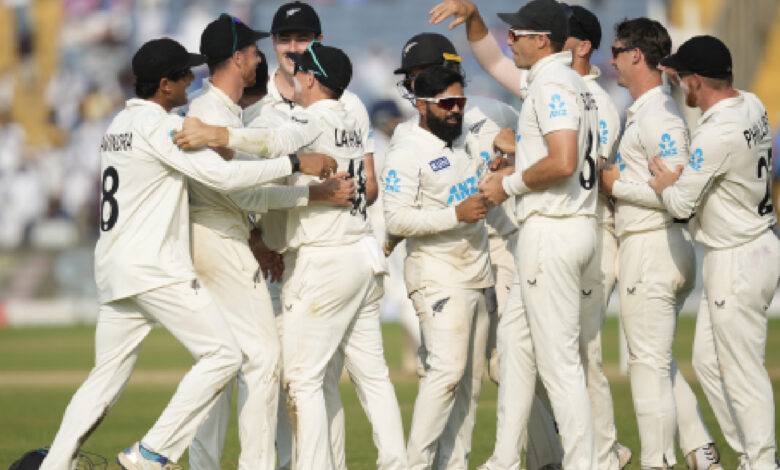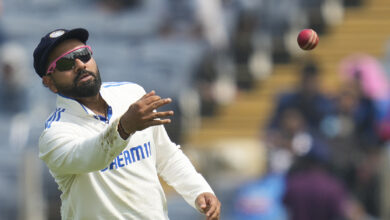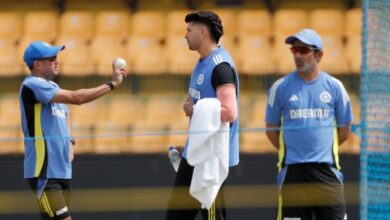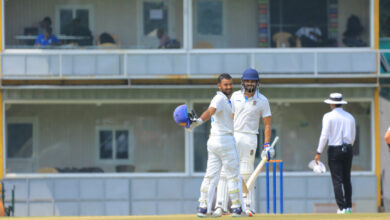New Zealand’s horic series win in India was built on courage of conviction and finding heroes for the occasion | Cricket News

In the stifling silence of a shocked MCA stadium, the screams of joy from the New Zealand huddle thundered the arena. The victorious men led Tom Latham high-fived and leapt around, grabbing souvenir stumps as an afterthought and sprinting around the ground thanking a crowd that barely bothered about giving them a standing ovation. It was a rare moment when they shed their fabled modesty and let their emotions explode after etching a rare hour of glory in India.Soon the default setting kicked in. From their space of celebration — near midwicket where Tim Southee had caught Ravindra Jadeja and formalised the victory — they sauntered to meet the gutted Indian cricketers and pacified them. Some of them are teammates in IPL, some are friends, and even in their most glorious hour, they did not lose their sense of propriety to console the defeated. The celebrations would soon resume — and it would spill deep into the night and for the rest of their tour. The good boys who came first truism rang loud in the stadium.
Later, Latham sympathised with the Indians. “One series defeat in 12 years doesn’t make them bad overnight. They played some good cricket, it was just that we were lucky enough to play better cricket,” he said, in a measured rather than hyper-excited tone.
Moments in Pune! 📸#INDvNZ #CricketNation pic.twitter.com/glKvto4h22
— BLACKCAPS (@BLACKCAPS) October 26, 2024
The cliche doesn’t fit them any longer. Rather, it’s a travesty to the quality they possess. All of these are true — modest, hardworking, undemonstrative — but they are more than that. The single most important quality that has got them to this level is the absolute conviction that they could always get there. They are carved of granite that shines through the finest of cricketers. In a sense, they are the real antithesis to Bazball. They keep calm and play old-school Test cricket: all observing the eternal verities, building an innings, bowling line and length, and giving every bit of their energy and elasticity on the field. It’s how they pipped India to win the World Test Championship final and it’s how they achieved their first series win in India.
Two weeks ago, they had wilted in Galle, losing both Tests against Sri Lanka. Tim Southee was sacked as captain, and replaced with Tom Latham. Just when they landed in India, arrived the news that their talismanic batsman Kane Williamson would not be fit enough for the first Test. He would miss the second too. Two-fourth of the fast-bowling axis that made them world champions in Tests – Trent Boult and Neil Wagner – have moved on. Another, Kyle Jamieson is recovering from injuries.
There was the burden of hory too. New Zealand had beaten India in India only twice in 34 Tests and never won a series. Now, they finally have, without any hype, build-up or posturing or verbal rattle. It is this backstory that makes the win more special. So to turn that around, and emerge so emphatically as the better side in every aspect of the game, including the level of fitness in which there is no better side in the world, represents a gargantuan achievement.
The decisions they made were bold. In Bengaluru, despite the overhead conditions, they resed the temptation to play an extra spinner. It could have backfired had they batted second. But it didn’t matter — so strong were they with their convictions. Similarly, they picked a spinner in Mitchell Santner for the injured Matt Henry. Even if Henry were fit, they would have drafted in Santner at the expense of a fast bowler, be it the seasoned Tim Southee or the rookie Will O’Rourke.
Significant dates ✍🏼
The team’s first EVER Test series victory in India. Scorecard | https://t.co/KgzR4y6Spp #INDvNZ pic.twitter.com/dvtZ710b0X
— BLACKCAPS (@BLACKCAPS) October 26, 2024
The clarity in planning was astounding. The batsmen were firm in their methods to durb India’s spinners with sweeps and reverse sweeps, stepping down the track and taking them on. The bowlers knew exactly the tools they needed to produce the results. In Bengaluru, the seamers pounded the good length area in the fourth-fifth stump channels. They dialled cutters and wobble seamers, instead of just relying on conventional variations.
In Pune, Mitchell Santner, channeling his inner Rangana Herath, mixed his angles and pace. He bowled at stumps more than the vaunted spin pair, kept the Indian batsmen quiet, and induced makes. Until this Test, Santner had performed precious little with the red ball. But they discovered heroes when they needed them — O’Rourke, Rachin Ravindra, Santner, Devon Conway, Southee, and in the final innings, Latham too.
It was a triumph of belief and spirit. There were times in the first Test when they seemed on the verge of squandering their massive first-innings advantage. But they regrouped and struck back with the second new ball. Here, they didn’t wither during Yashasvi Jaiswal’s onslaught. Like their Trans-Tasman rivals, they waited for the opportune moments to strike and grab the match.
The two Tests in Sri Lanka helped in terms of devising strategies to nullify spin. Latham admitted: “It was about trying to stick to our basics and doing as best as we can and I guess trying to play the long game here. We talk about firing a shot and I think we have done that over the last two games.” And they won a series without losing their innocence too.







